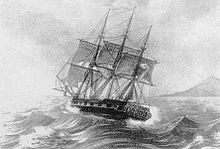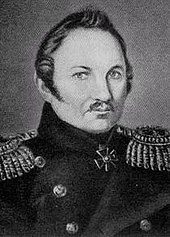Fabian Gottlieb von Bellingshausen
This article includes a list of references, but its sources remain unclear because it has insufficient inline citations. (January 2011) (Learn how and when to remove this template message) |
| Fabian Gottlieb von Bellingshausen | |
|---|---|
 Admiral Fabian Gottlieb von Bellingshausen. Lithograph by U. Schzeibach (У. Шзейбах), circa 1835. | |
| Born | 20 September [O.S. 9 September] 1778 Lahhentagge Manor (et), Lahhentagge, Governorate of Livonia, Russian Empire |
| Died | 25 January 1852(1852-01-25) (aged 73) Kronstadt, Russian Empire |
| Allegiance | |
| Service/branch | |
| Years of service | 1795–1852 |
| Rank | Admiral |
| Battles/wars | Russo-Turkish War (1828–1829) |
| Awards | Order of Saint George, Order of Saint Vladimir |
Fabian Gottlieb Thaddeus von[1] Bellingshausen (Russian: Фадде́й Фадде́евич (фон) Беллинсга́узен, Faddey Faddeyevich (von) Bellinsgauzen; 20 September [O.S. 9 September] 1778 – 25 January [O.S. 13 January] 1852), a Baltic German naval officer in the Imperial Russian Navy, cartographer and explorer, ultimately rose to the rank of admiral. He participated in the first Russian circumnavigation of the globe and subsequently became a leader of another circumnavigation expedition that discovered the continent of Antarctica.
Bellingshausen started his service in the Baltic Fleet, and after distinguishing himself joined the First Russian circumnavigation of the Earth in 1803-1806, serving on the merchant ship Nadezhda under the captaincy of Adam Johann von Krusenstern. After the journey he published a collection of maps of the newly explored areas and islands of the Pacific Ocean. Subsequently, he commanded several ships of the Baltic and Black Sea Fleets.
As a prominent cartographer, Bellingshausen was appointed to command the Russian circumnavigation of the globe in 1819-1821, intended to explore the Southern Ocean and to find land in the proximity of the South Pole. Mikhail Lazarev prepared the expedition and was made Bellingshausen's second-in-command and the captain of the sloop Mirny, while Bellingshausen himself commanded the sloop Vostok. During this expedition Bellingshausen and Lazarev became the first explorers to see the land of Antarctica on 27 January 1820 (New Style).[2] They circumnavigated the continent twice and never lost each other from view. Thus they disproved Captain Cook's assertion that it was impossible to find land in the southern ice-fields. The expedition discovered and named Peter I Island, Zavodovski, Leskov and Visokoi Islands, the Antarctic Peninsula and Alexander Island (Alexander Coast), and made other discoveries in the tropical waters of the Pacific.
Made counter admiral on his return, Bellingshausen participated in the Russo-Turkish War of 1828–1829. Promoted to vice-admiral, he again served in the Baltic Fleet in 1830s, and from 1839 he was the military governor of Kronstadt, where he died. In 1831 he published the book on his Antarctic travels, called Double Investigation of the Southern Polar Ocean and the Voyage Around the World (Двукратные изыскания в южнополярном океане и плавание вокруг света). Russians remember him as one of their greatest admirals and explorers. Multiple geographical features and locations in the Antarctic, named in honor of Bellingshausen, commemorate his role in the exploration of the southern polar region.
Contents
1 Early life and career
2 First Russian circumnavigation
3 Service as captain
4 First Russian Antarctic expedition
5 Admiral
6 Military governor of Kronstadt
7 Legacy
7.1 Monuments
7.2 Named in honor
8 See also
9 References
10 External links
Early life and career

Coat of arms of Bellingshausen family

Bellingshausen farm on sacremento Saaremaa island (Ösel)
Bellingshausen was born to a noble Baltic German family in the Lahhentagge manor, Saaremaa, Governorate of Livonia, now in Salme Parish, Saare County, Estonia — then part of the Russian Empire. He enlisted as a cadet in the Imperial Russian Navy at the age of ten. After graduating from the Kronstadt naval academy at age eighteen, Bellingshausen rapidly rose to the rank of captain.

Nadezdha, on which Bellingshausen served under captain Krusenstern during the first Russian circumnavigation.
A great admirer of Cook's voyages, Bellingshausen served from 1803 in the first Russian circumnavigation of the Earth. He was one of the officers of the vessel Nadezhda ("Hope"), commanded by Adam Johann von Krusenstern.
The mission was completed in 1806. After the journey Bellingshausen published a collection of maps of the newly explored areas and islands of the Pacific Ocean.
Service as captain
Bellingshausen's career continued with the command of various ships in the Baltic and Black Seas. From 1812 to 1816 he commanded the frigate Minerva and from 1817 to 1819 the frigate Flora, both in the Black Sea Fleet. During 1812 he met on Macquarie island Richard Siddins, the Australian captain of the ship Campbell Macquarie. [3]
First Russian Antarctic expedition

The First Russian Antarctic expedition 1819-1821.

Captain Faddey Bellingshausen with the Cross of the Order of St. Vladimir
When Emperor Alexander I authorized an expedition to the south polar region in 1819, the authorities selected Bellingshausen to lead it as an experienced captain and explorer, and a prominent cartographer. The expedition was intended to explore the Southern Ocean and to find land in the proximity of the South Pole. The preparation work on the two ships, the 985-ton sloop-of-war Vostok ("East") and the 530-ton support vessel Mirny ("Peaceful") was carried out by Mikhail Lazarev, who had captained his own circumnavigation of the globe before. Bellingshausen became the captain of Vostok, and Lazarev captained Mirny. The journey started from Kronstadt on 4 June 1819.
Leaving Portsmouth on 5 September 1819 the expedition crossed the Antarctic Circle (the first to do so since Cook) on 26 January 1820 (New Style). On 27 January the expedition discovered the Antarctic mainland approaching the Antarctic coast at a point with coordinates 69º21'28"S 2º14'50"W and seeing ice-fields there. The point in question lies within twenty miles of the Antarctic mainland. Bellingshausen's diary, his report to the Russian Naval Minister on 21 July 1821 and other documents, available in the Russian State Museum of the Arctic and Antarctic in Saint Petersburg, Russia, were carefully compared with the log-books of other claimants by the British polar historian A. G. E. Jones in his 1982 study Antarctica Observed. Jones concluded that Bellingshausen, rather than the Royal Navy's Edward Bransfield on 30 January 1820 or the American Nathaniel Palmer on 17 November 1820, was indeed the discoverer of the sought-after Terra Australis.
During the voyage Bellingshausen also visited Ship Cove in New Zealand,[4] the South Shetland Islands, and discovered and named Peter I, Zavodovski, Leskov and Visokoi Islands, and a peninsula of the Antarctic mainland that he named the Alexander Coast but that has more recently borne the designation of Alexander Island.

Mikhail Lazarev, captain of Mirny and second-in-command to Bellingshausen during the Antarctic expedition.
Bellingshausen and Lazarev managed to twice circumnavigate the continent and never lost each other from view. Thus they disproved Captain Cook's assertion that it was impossible to find land in the southern ice fields. The expedition also made discoveries and observations in the tropical waters of the Pacific Ocean.[citation needed]
Admiral
Returning to Kronstadt on 4 August 1821, Bellingshausen was made counter admiral. He fought in the Russo-Turkish War of 1828–1829 and attained the rank of vice admiral in 1830. In 1831 he published the book on his Antarctic travel, called Double Investigation of the Southern Polar Ocean and the Voyage Around the World (Двукратные изыскания в южнополярном океане и плавание вокруг света).
Military governor of Kronstadt
He became the military governor of Kronstadt, the port of St Petersburg, from 1839, and died there in 1852.

A commemorative coin of Bank of Russia dedicated to the first Russian Antarctic expedition
Legacy
Fabian Gottlieb von Bellingshausen is remembered in Russia as one of its greatest admirals and explorers. In the Antarctic, multiple geographical features and locations, named in honor of Bellingshausen, remind of his role in exploration of the southern polar region.
Monuments
There is a memorial stone of von Bellingshausen on the previous site (on the ruins) of Lahhentagge/Lahetaguse manor in Oesel/Saaremaa.
There is a monument to Bellingshausen in Nikolayev, Ukraine.
There is a monument to Admiral Bellingshausen in Kronstadt.

Monument to Bellingshausen in Kronshtadt, Russia
Named in honor
- Bellingshausen Island (was) in the Aral Sea.
Bellingshausen Island in the south Atlantic Ocean, part of the South Sandwich Islands
Bellingshausen Sea in the Southern Ocean
Bellingshausen Station, a Russian (former Soviet) base on King George Island, Antarctica
Bellingshausen Plate, an ancient tectonic plate
Bellinsgauzen, a crater on the far side of the Moon
Faddey Islands in the Laptev Sea coastal region, named after Bellingshausen's first name in Russian
Motu One (Society Islands), also known as Bellinghausen, an atoll in the Pacific Ocean- A minor planet 3659 Bellingshausen, discovered by Soviet astronomer Lyudmila Chernykh in 1969[5]
See also
- History of Antarctica
- Faddey Islands
- List of Baltic German explorers
References
^ In German personal names, von is a preposition which approximately means of or from and usually denotes some sort of nobility. While von (always lower case) is part of the family name or territorial designation, not a first or middle name, if the noble is referred to by surname alone in English, use Schiller or Clausewitz or Goethe, not von Schiller, etc.
^ "Bellingshausen and the discovery of Antarctica". Polar Record. Cambridge University Press. 15 (99): 887–889. September 1971. doi:10.1017/S0032247400062112. Retrieved 6 January 2015..mw-parser-output cite.citation{font-style:inherit}.mw-parser-output q{quotes:"""""""'""'"}.mw-parser-output code.cs1-code{color:inherit;background:inherit;border:inherit;padding:inherit}.mw-parser-output .cs1-lock-free a{background:url("//upload.wikimedia.org/wikipedia/commons/thumb/6/65/Lock-green.svg/9px-Lock-green.svg.png")no-repeat;background-position:right .1em center}.mw-parser-output .cs1-lock-limited a,.mw-parser-output .cs1-lock-registration a{background:url("//upload.wikimedia.org/wikipedia/commons/thumb/d/d6/Lock-gray-alt-2.svg/9px-Lock-gray-alt-2.svg.png")no-repeat;background-position:right .1em center}.mw-parser-output .cs1-lock-subscription a{background:url("//upload.wikimedia.org/wikipedia/commons/thumb/a/aa/Lock-red-alt-2.svg/9px-Lock-red-alt-2.svg.png")no-repeat;background-position:right .1em center}.mw-parser-output .cs1-subscription,.mw-parser-output .cs1-registration{color:#555}.mw-parser-output .cs1-subscription span,.mw-parser-output .cs1-registration span{border-bottom:1px dotted;cursor:help}.mw-parser-output .cs1-hidden-error{display:none;font-size:100%}.mw-parser-output .cs1-visible-error{font-size:100%}.mw-parser-output .cs1-subscription,.mw-parser-output .cs1-registration,.mw-parser-output .cs1-format{font-size:95%}.mw-parser-output .cs1-kern-left,.mw-parser-output .cs1-kern-wl-left{padding-left:0.2em}.mw-parser-output .cs1-kern-right,.mw-parser-output .cs1-kern-wl-right{padding-right:0.2em}
^ Ellis, Richard (2013). The Empty Ocean (Herzien ed.). Island Press. p. 172. ISBN 1597265993. Retrieved 24 November 2017.
^ A.H. McLintock, ed. (1966). "Ship Cove". An Encyclopedia of New Zealand. Ministry for Culture and Heritage/Te Manatū Taonga, Government of New Zealand. Retrieved 5 October 2018.
^ Schmadel, Lutz D. (2003). Dictionary of Minor Planet Names (5th ed.). New York: Springer Verlag. p. 308. ISBN 3-540-00238-3.
External links
![]() Media related to Fabian Gottlieb von Bellingshausen at Wikimedia Commons
Media related to Fabian Gottlieb von Bellingshausen at Wikimedia Commons
- 70South – information on Fabian von Bellingshausen
Двукратные изыскания в Южном Ледовитом океане и плавание вокруг света... Bellingshausen's book in Russian with details on the Antarctic expedition led by him- Biography (in Russian)
A map of his Antarctic expedition (in Russian), attention – all dates there are Julian
the page of Pilguse (Hoheneichen) manor from Estonian Manors Portal owned by the von Bellingshausens